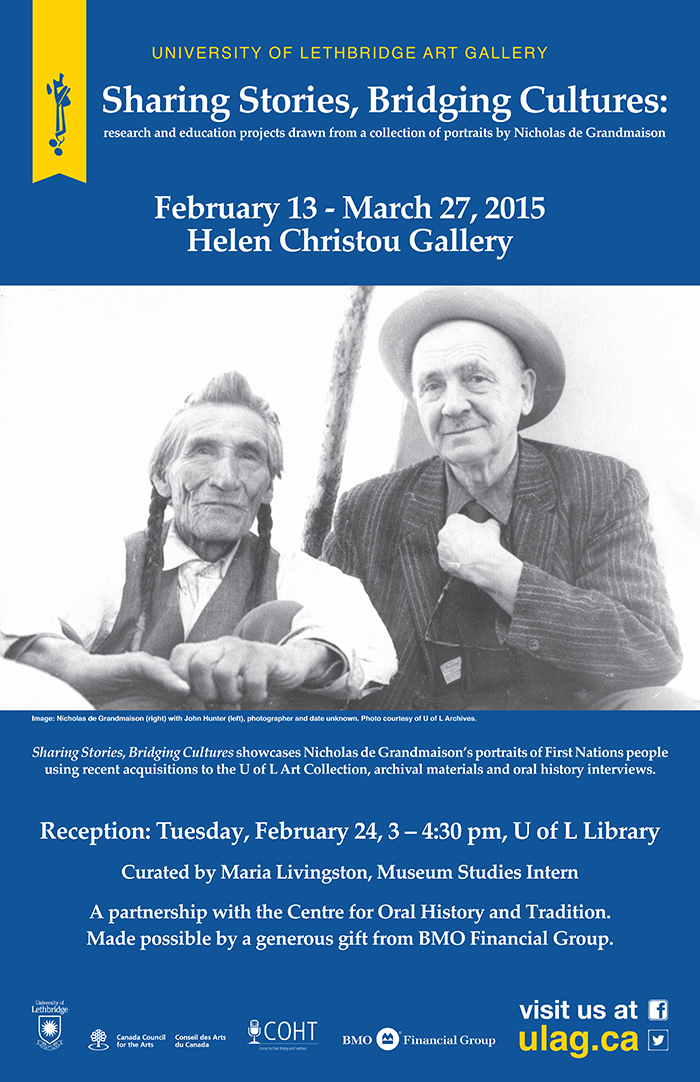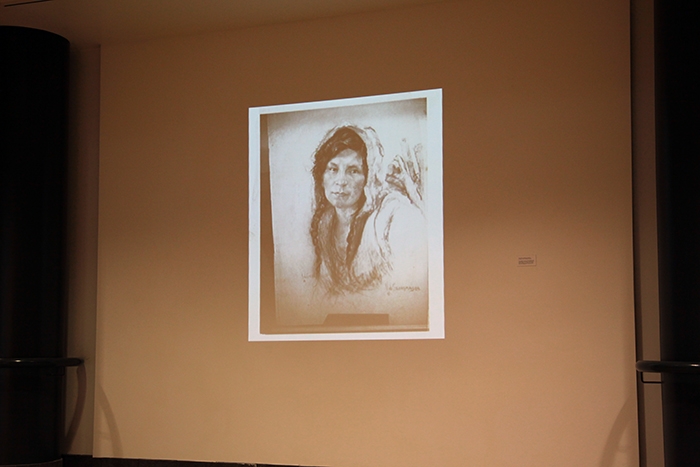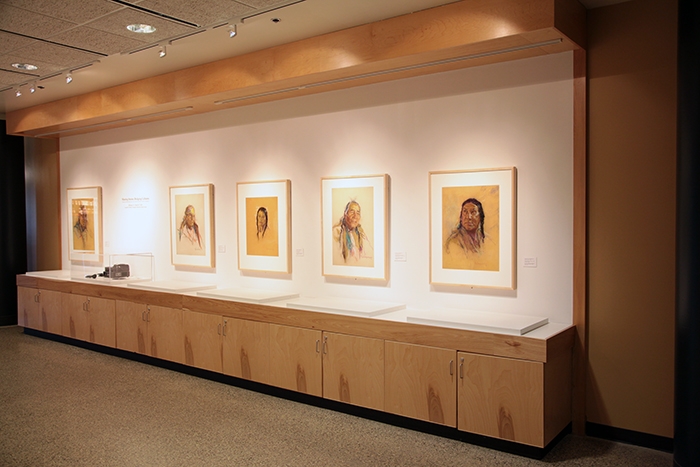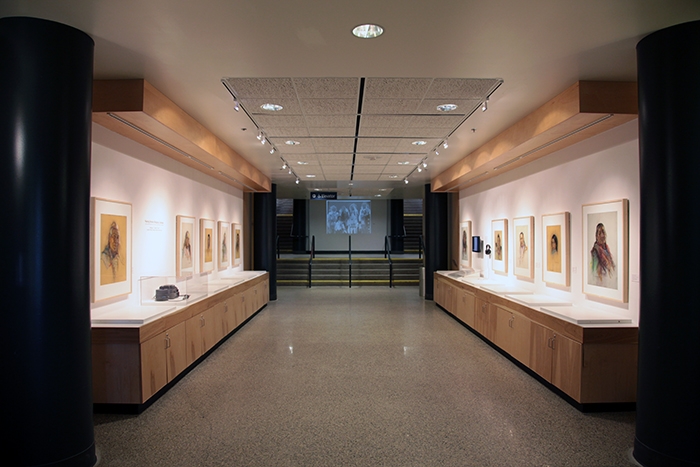Helen Christou Gallery
Sharing Stories, Bridging Cultures
February 13 – March 27, 2015
Sharing Stories, Bridging Cultures: research and education projects drawn from a collection of portraits by Nicholas de Grandmaison
Made possible by a generous gift from BMO Financial Group
Curated by Maria Livingston, Museum Studies Intern
A partnership with the Centre for Oral History and Tradition (COHT).
Curated by museum studies intern Maria Livingston, Sharing Stories, Bridging Cultures showcases Nicholas de Grandmaison’s portraits of First Nations people using recent acquisitions to the U of L Art Collection, archival materials and oral history interviews.
Sharing Stories, Bridging Cultures combines materials between cultures and through generations—finding connections amongst the U of L Art Gallery collection, University Archives and recent oral histories. Artist Nicholas de Grandmaison portrayed First Nations people in his works with exceptional skill and ability to capture their individual character. De Grandmaison held a deep respect for the people whom he painted as evident in his work.
The Nicholas de Grandmaison Oral history Project began in spring 2013 and information gathered from this project will be included in the exhibition. Still on-going, the oral history project brings multiple generations together through discovering the stories behind the subjects in the portraits. The project includes interviews that have contributed to creating connections between the artist, his work, and the subjects in the portraits. So far, project team members have interviewed many individuals who hold a connection to those in the portraits or the artist himself. These interviews are then used for further learning such as in lesson plans, interactive tours to students, and with audiences in exhibitions.
Curatorial Statment
Sharing Stories, Bridging Cultures enhances understanding between cultures and across generations – the exhibition shows connections between the U of L Art Collection, the Archives, and recent oral histories. Researchers with the Nicholas de Grandmaison Oral History Project have conducted interviews with individuals with close ties to the artist and those in the portraits. These stories contribute to a growing understanding of both the artist and his sitters thereby enhancing the current perspective on the collection. Lethbridge sits on traditional Blackfoot territory and this local knowledge and history is an important context for the U of L Art Collection and Archives.
The University of Lethbridge holds the most comprehensive collection of work by Nicholas de Grandmaison (1892-1978). Building on an original donation from the artist’s family, this collection increased in 2012 with a generous donation from BMO Financial Group of 67 portraits as well as financial support for research and preservation. Sharing Stories, Bridging Cultures includes newly reframed pastel portraits of Blackfoot people drawn from the BMO donation to the U of L Art Gallery. As well, courtesy of the U of L Archives, there is an audio station with excerpts from the de Grandmaison Oral History Project and from original interviews conducted by the artist during the 1950s; the actual audiograph recorder used by the artist; and a slideshow of historical photographs featured on the far wall.
Born in Russia to an aristocratic family, de Grandmaison was an officer in the Russian army in WWI and was held as a prisoner of war for four years. In 1923, he immigrated to Eastern Canada and eventually made Southern Alberta his home. Often described as eccentric, he was able to capture the unique personality of those he portrayed. He became well known as a portrait artist and earned his living being commissioned to create portraits of many politicians and dignitaries, but developed a strong connection with First Nations people and created these portraits for his own interest. He spent time getting to know his First Nations sitters and their families while working on the pastels, becoming a welcomed guest in the community. Some notable recognition received by the artist includes receiving the Order of Canada in 1972, receiving an honorary doctorate from the University of Calgary, and becoming an honorary member of the Pikanni nation. He was an extraordinary artist whose appreciation for those he portrayed is evident in his work.
The de Grandmaison Oral history Project began in early 2013 with a key objective to add a stronger First Nations perspective to the U of L’s de Grandmaison collection by seeking information on those individuals portrayed. Still on-going, the oral history project brings multiple generations together through discovering the stories behind the subjects in the portraits. Before starting the project, consultation with local Blackfoot community members emphasized the importance of giving this information back to the community. The information gathered is being shared with larger audiences through educational programming, the U of L Art Gallery’s and Library’s websites, and exhibitions such as these. For more information on the online education programs and the oral history project, please visit: www.ulag.ca and www.uleth.ca/lib.
– Maria Livingston, Museum Studies Intern
About the Curator
Maria Livingston is a member of the Bigstone Cree First Nation, pursuing her Bachelor of Arts degree with a major in Native American Studies. Livingston practices traditional and contemporary Cree culture within all aspects of her life. She credits her personal and academic experience as enabling her to be a suitable researcher and a valuable team member of the Nicholas de Grandmaison Oral History Project.







